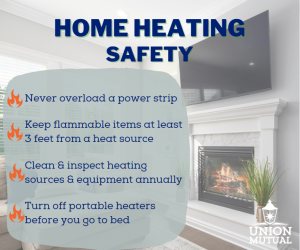Home Heating Safety
 Temps continue to fall and winter weather is upon us – time to fire up the heating sources in our homes! Not only is a warm home comfortable, it will keep your pipes from freezing – leading to costly and inconvenient damage. It’s important to pay attention to the safety features of our heating devices – stoves, fireplaces (gas, pellet or wood-fired), portable heaters, furnaces, etc. – to help prevent a devastating fire or related loss.
Temps continue to fall and winter weather is upon us – time to fire up the heating sources in our homes! Not only is a warm home comfortable, it will keep your pipes from freezing – leading to costly and inconvenient damage. It’s important to pay attention to the safety features of our heating devices – stoves, fireplaces (gas, pellet or wood-fired), portable heaters, furnaces, etc. – to help prevent a devastating fire or related loss.
Here are some helpful tips to ensure your home is warm and safe throughout the cold-weather season:
- Never overload a power strip. And, never plug a space heater into a power strip – the power strip is not designed to provide the amount of power needed to run the heater and will cause the strip to melt and/or catch on fire.
- Keep flammable items at least 3 feet from your heat source. Do not store wood within 3 feet of your stove or fireplace, and remove books, kindling, newspaper, blankets, curtains, decorations, etc. Be sure a grate or screen is installed to prevent sparks from jumping from the fireplace to ignite a nearby object.
- Have a professional inspect and clean your chimney, furnace, etc. annually. You may have hidden damage from the previous year and it’s always a good idea to remove any soot or other buildup from the chimney to keep it performing efficiently and safely.
- Turn off portable heaters before you go to bed. Use a space heater to warm a small section of your office or living room? Be sure to turn it off before you leave the room and/or go to bed. Consider it an electric candle – you wouldn’t leave a candle burning while you sleep, so don’t leave the space heater running, either. Do not use a space heater as your primary source of heat – it will not reach the pipes in your home, which will lead to a burst pipe and resulting property damage.
- Be sure to use appropriate fuel for your heating devices. Dry, seasoned wood for wood stoves and fire places; proper pellets for your model pellet stove; appropriate fuel for your furnace, etc. will ensure not only that the device runs efficiently, but it will also result in safer air to breathe and help reduce the risk of fire.
- Make sure smoke and carbon monoxide detectors are properly installed and working throughout your home. Heat sources can produce harmful carbon monoxide without you knowing – test your detectors routinely.
Additional Resources:
Union Mutual blog post: Never Overload a Power Strip



